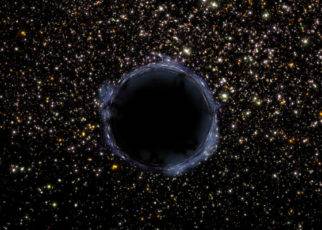A tribute article to Stephen Hawking (1942-2018)
Another new first has been achieved for astronomers studying the elusive and mysterious objects known as black holes. Astronomers at the National Optical Astronomy Observatory (NOAO) have detected the signature of two massive black holes at the center of one galaxy.
Black Holes, Galactic Cores, and Quasars
It has long been known that massive black holes lie at the heart of most galaxies in the Universe. Black holes are recognized by their surroundings. As the surrounding material is sucked into a black hole, it does not fall directly in but swirls around the black hole, much like water swirls around an open drain. It is the creation of this flat accretion disk of stellar material surrounding the black hole that can create quasars. A quasar is the nucleus in an active galaxy. Quasars have high red-shifts, indicating that they are much father away from us than other galaxies in the Universe and revealing that such active galaxies were more common in the past. More than 100,000 quasars have been discovered lying billions of light-years from Earth.
Black holes are found in galactic cores by the spectral signature of the material in the accretion disk. The emission lines give scientists information about the speed and direction of the material around the black hole. The search for twin black holes required astronomers to look for a dual signature in the emission lines. This is just what former NOAO Director Todd Boroson and NOAO Astronomer Tod Lauer have found using data from the Sloan Digital Sky Survey.
The Fate of Black Holes in Galactic Mergers
Galaxies, particularly those in clusters, can collide and merge into one larger galaxy. The question is, what happens to the black holes in these galaxies’ nuclei? Current theory predicts that the black holes will orbit one another until they eventually merge into one large black hole.
When Boroson and Lauer found the dual signature in the emission lines, they first had to rule out that they were seeing two black holes in separate galaxies, positioned one in front of the other. Using red-shifted distance, they discovered that the two black holes were, indeed in the same location.
“The double set of broad emission lines is pretty conclusive evidence of two black holes,” Boroson explains. “If in fact this were a chance superposition, one of the objects must be quite peculiar.”
Future observations will help to cement their case. “One nice thing about this binary black hole system is that we predict that we will see observable velocity changes within a few years at most. We can test our explanation that the binary black hole system is embedded in a galaxy that is itself the result of a merger of two smaller galaxies, each of which contained one of the two black holes.”
The two black holes are separated by 1/10 of a parsec, which is equal to 1/3 of a light-year or a tenth of the distance from the Sun to the nearest star. The smaller black hole has a mass 20 million times that of the Sun and the larger one is 50 times bigger. The black holes complete an orbit around their center of mass every 100 years, traveling at 6,000 kilometers per second.





